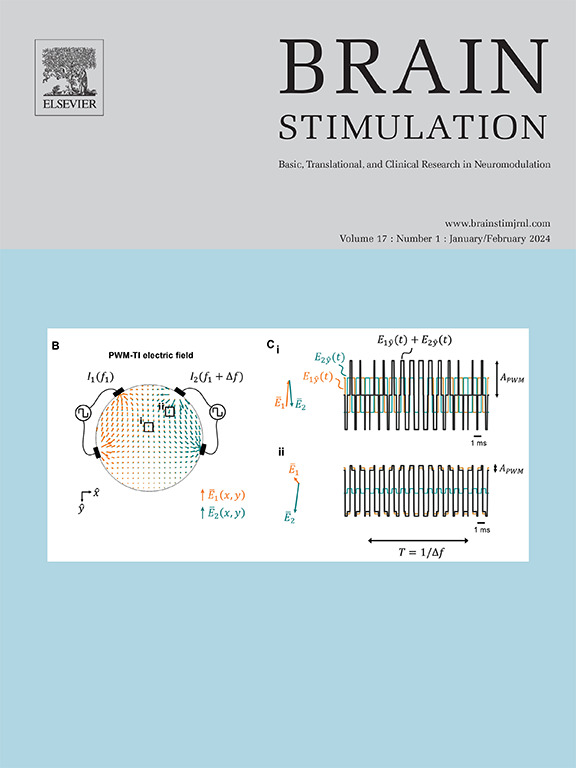Comparison of ultra-ultrabrief and ultrabrief pulse widths in right unilateral electroconvulsive therapy: A randomized trial
IF 7.6
1区 医学
Q1 CLINICAL NEUROLOGY
引用次数: 0
Abstract
Background
Ultrabrief stimulation in electroconvulsive therapy (ECT) using a 0.25 or 0.30 ms pulse width markedly reduces the charge required to reach the seizure threshold (ST) and cognitive side effects. It is not known whether further reduction of pulse width to 0.15 ms is advantageous.
Methods
Thirty-seven patients were randomized to ST titration at the first session applying right unilateral (RUL) ECT with either a 0.15 or 0.30 ms pulse width and were titrated again in the second session using the alternative pulse width. All subsequent treatments used the pulse width applied in the second titration session, administering RUL ECT, starting at 6xST. The primary outcome was difference between the pulse widths in ST at the two titration sessions. Exploratory analyses examined differences in seizure duration and postictal time to recover orientation (TRO), averaged across all ECT sessions from the third onwards. Other exploratory analyses examined clinical improvement and retrograde amnesia for autobiographical information and other neuropsychological functions following the ECT course.
Results
In the first titration session, ST was significantly lower with the 0.15 ms than 0.30 ms pulse width. ST significantly increased when re-titrating with the 0.30 ms pulse width and significantly decreased when re-titrating with a 0.15 ms pulse width. There were no differences between the pulse width groups in clinical improvement, TRO, or neuropsychological measures.
Conclusions
Ultra-ultrabrief stimulation with a 0.15 ms pulse width is more efficient in seizure induction than a 0.30 ms pulse width. Comprehensive studies should determine whether ultra-ultrabrief stimulation replaces ultrabrief stimulation as a default parameter for ECT.
右单侧电休克疗法中超短脉冲宽度与超短脉冲宽度的比较:随机试验。
背景:在电痉挛治疗(ECT)中使用0.25或0.30 ms脉冲宽度的超短刺激可显著降低达到癫痫阈值(ST)所需的电荷和认知副作用。目前尚不清楚将脉冲宽度进一步减小到0.15 ms是否有利。方法:37例患者在第一阶段随机接受右单侧(RUL)电痉挛滴定,脉宽为0.15或0.30 ms,在第二阶段使用替代脉宽再次滴定。所有后续治疗均使用第二次滴定时的脉冲宽度,从6xST开始实施RUL ECT。主要结果是两次滴定时ST脉宽的差异。探索性分析检查了癫痫发作持续时间和恢复定向后时间(TRO)的差异,从第三次开始的所有ECT疗程中取平均值。其他探索性分析检查了在ECT课程后临床改善和自传体信息和其他神经心理功能的逆行性健忘症。结果:第一次滴定时,脉宽为0.15 ms时ST明显低于0.30 ms时。当脉冲宽度为0.30 ms时,ST显著升高,而当脉冲宽度为0.15 ms时,ST显著降低。脉宽组在临床改善、TRO或神经心理测量方面没有差异。结论:脉冲宽度为0.15 ms的超短刺激比脉冲宽度为0.30 ms的刺激更有效地诱导癫痫发作。全面的研究应该确定超短时间刺激是否取代超短时间刺激作为ECT的默认参数。
本文章由计算机程序翻译,如有差异,请以英文原文为准。
求助全文
约1分钟内获得全文
求助全文
来源期刊

Brain Stimulation
医学-临床神经学
CiteScore
13.10
自引率
9.10%
发文量
256
审稿时长
72 days
期刊介绍:
Brain Stimulation publishes on the entire field of brain stimulation, including noninvasive and invasive techniques and technologies that alter brain function through the use of electrical, magnetic, radiowave, or focally targeted pharmacologic stimulation.
Brain Stimulation aims to be the premier journal for publication of original research in the field of neuromodulation. The journal includes: a) Original articles; b) Short Communications; c) Invited and original reviews; d) Technology and methodological perspectives (reviews of new devices, description of new methods, etc.); and e) Letters to the Editor. Special issues of the journal will be considered based on scientific merit.
 求助内容:
求助内容: 应助结果提醒方式:
应助结果提醒方式:


